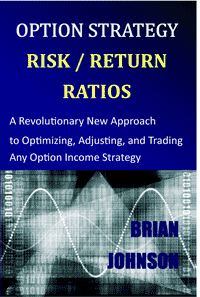About Brian Johnson
I have been an investment professional for over 30 years. I worked as a fixed income portfolio manager, personally managing over $13 billion in assets for institutional clients. I was also the President of a financial consulting and software development firm, developing artificial intelligence based forecasting and risk management systems for institutional investment managers.
I am now a full-time proprietary trader in options, futures, stocks, and ETFs using both algorithmic and discretionary trading strategies.
In addition to my professional investment experience, I designed and taught courses in financial derivatives for both MBA and undergraduate business programs on a part-time basis for a number of years. I have also written four books on options and derivative strategies.
The following is the second in a series of video demonstrations of spreadsheet tools that accompany my new book: Exploiting Earnings Volatility: An Innovative New Approach to Evaluating, Optimizing, and Trading Option Strategies to Profit from Earnings Announcements. The following … Continue reading →
Posted in Options, Strategy Development, Video
|
Tagged Brian Johnson, Exploiting Earnings Volatility, implied earnings volatility, implied volatility, option, option strategy, spreadsheet demo, Trader Edge, video, video demo
|
This article presents the Trader Edge aggregate neural network model forecast for the April 2015 non-farm payroll data, which is scheduled to be released tomorrow morning at 8:30 AM EDT.
The following is the first video demo of the spreadsheet tools that accompany my new book: Exploiting Earnings Volatility: An Innovative New Approach to Evaluating, Optimizing, and Trading Option Strategies to Profit from Earnings Announcements. The following video demonstrates how … Continue reading →
Posted in Options, Strategy Development, Video
|
Tagged Brian Johnson, Exploiting Earnings Volatility, implied earnings volatility, implied volatility, option, option strategy, spreadsheet demo, Trader Edge, video, video demo
|
The April 30, 2015 AAR Strategy update is now available on the AAR Subscribers page. If you are not currently a subscriber and would like to learn more about the strategy, there is a detailed description on the AAR Strategy … Continue reading →
Posted in Asset Allocation Rotational (AAR) Strategy, Market Sentiment, Risk Management, Strategy Development, Technical Analysis
|
Tagged asset allocation, asset allocation rotational strategy, asset allocation strategy, Ivy League Portfolio, rotatinal strategy, trade, Trader Edge
|
The Print version of my second options book, Exploiting Earnings Volatility: An Innovative New Approach to Evaluating, Optimizing, and Trading Option Strategies to Profit from Earnings Announcements, is currently the #1 new release in Options Trading on Amazon. The Kindle … Continue reading →
The following article updates the diffusion index, recession slack index, aggregate recession model, and aggregate peak-trough model through March 2015. In January 2015, I created a new explanatory variable for a new market-based indicator, bringing the total number of explanatory … Continue reading →
Posted in Economic Indicators, Market Commentary, Market Timing, Recession Forecasting Model
|
Tagged aggregate peak-trough model, aggregate recession model, diffusion index, logit model, probit model, recession forecast, recession forecast March 2015, Recession Slack Index, Trader Edge
|
The Print and Kindle versions of my second options book, Exploiting Earnings Volatility: An Innovative New Approach to Evaluating, Optimizing, and Trading Option Strategies to Profit from Earnings Announcements, are now available on Amazon. The print version became available earlier … Continue reading →
The Kindle version of my second options book, Exploiting Earnings Volatility: An Innovative New Approach to Evaluating, Optimizing, and Trading Option Strategies to Profit from Earnings Announcements, is now available on Amazon. The print version will be available on Amazon … Continue reading →













Recession Model Forecast 04-01-2015
The following article updates the diffusion index, recession slack index, aggregate recession model, and aggregate peak-trough model through March 2015. In January 2015, I created a new explanatory variable for a new market-based indicator, bringing the total number of explanatory … Continue reading →